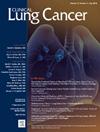Augmenting Prognostication: Utilizing Activity Trackers to Enhance Survival Prediction in Metastatic Non-Small Cell Lung Cancer
IF 3.3
3区 医学
Q2 ONCOLOGY
引用次数: 0
Abstract
Introduction/Background
Prognostication by performance status (PS) assessment is a fundamental element of treatment decisions and clinical trial design in oncology, but it is limited by subjectivity and potential miscommunication between patient, physician, and family. Activity tracker offers the potential to collect a broad range of patient-generated data to supplement the assessment of PS.
Patients and Methods
Patients with metastatic NSCLC (mNSCLC) participated in a single institute, prospective, observational feasibility study conducted at Huntsman Cancer Institute. Patients were given a Fitbit® activity tracker, which collects their steps taken, distance moved, heart rate, and activity intensity. At baseline, PS was assessed by physicians and patients, and demographics and clinical data were collected. We defined novel indices of health: Heart rate Activity zone Mismatch (HAM) and excessive Sedentary Heart Rate (eSHR). We used multivariable Cox proportional hazards models adjusted for age, sex, and treatment line to estimate and test the prognostic ability of clinical and fitness metrics on overall survival (OS). Each prognostic model was evaluated using Harrell's concordance index (C-index).
Results
Fifty-five patients with mNSCLC were enrolled. The median OS was 10.4 months (95% CI: 7.2, 15.2). PS-physician (HR = 2.0; P < .001) and Fitbit metrics were associated with OS, including daily total steps (1,000-steps) (HR = 0.8; P = .004), HAM (HR = 2; P = .02), eSHR (HR = 0.3; P = .001). The prognostic model that includes PS-physician was associated with the best concordance (C-index = 0.75), followed by daily total distance (C-index = 0.74) and steps (C-index = 0.73)
Conclusions
Tracker-based measures were prognostic of survival in mNSCLC and may be useful as a supplement or alternative to PS in practice and clinical trials.
增强预后:利用活动追踪器加强转移性非小细胞肺癌的生存预测
导言/背景:通过表现状态(PS)评估进行诊断是肿瘤学治疗决策和临床试验设计的基本要素,但它受到主观性以及患者、医生和家属之间潜在沟通不畅的限制。活动追踪器可以收集患者提供的各种数据,作为PS评估的补充:转移性 NSCLC(mNSCLC)患者参加了亨斯迈癌症研究所开展的一项单一研究所、前瞻性、观察性可行性研究。研究人员向患者发放了 Fitbit® 活动追踪器,用于收集他们的步数、移动距离、心率和活动强度。在基线阶段,医生和患者对 PS 进行评估,并收集人口统计学和临床数据。我们定义了新的健康指数:心率活动区不匹配(HAM)和过度静坐心率(eSHR)。我们使用经年龄、性别和治疗方案调整的多变量考克斯比例危险模型来估计和检验临床指标和健康指标对总生存期(OS)的预后能力。使用哈雷尔一致性指数(C-index)对每个预后模型进行评估:55名mNSCLC患者入选。中位OS为10.4个月(95% CI:7.2,15.2)。PS-医生(HR = 2.0;P < .001)和Fitbit指标与OS相关,包括每日总步数(1000步)(HR = 0.8;P = .004)、HAM(HR = 2;P = .02)、eSHR(HR = 0.3;P = .001)。包括 PS-医生的预后模型具有最佳一致性(C-指数 = 0.75),其次是每日总距离(C-指数 = 0.74)和步数(C-指数 = 0.73):基于追踪器的测量方法可预测 mNSCLC 患者的生存期,可作为实践和临床试验中 PS 的补充或替代方法。
本文章由计算机程序翻译,如有差异,请以英文原文为准。
求助全文
约1分钟内获得全文
求助全文
来源期刊

Clinical lung cancer
医学-肿瘤学
CiteScore
7.00
自引率
2.80%
发文量
159
审稿时长
24 days
期刊介绍:
Clinical Lung Cancer is a peer-reviewed bimonthly journal that publishes original articles describing various aspects of clinical and translational research of lung cancer. Clinical Lung Cancer is devoted to articles on detection, diagnosis, prevention, and treatment of lung cancer. The main emphasis is on recent scientific developments in all areas related to lung cancer. Specific areas of interest include clinical research and mechanistic approaches; drug sensitivity and resistance; gene and antisense therapy; pathology, markers, and prognostic indicators; chemoprevention strategies; multimodality therapy; and integration of various approaches.
 求助内容:
求助内容: 应助结果提醒方式:
应助结果提醒方式:


